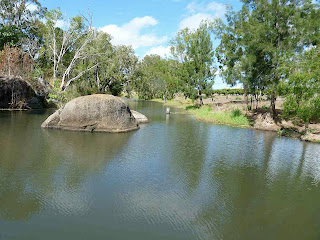
Lake
Eacham is a Crater Lake and is a popular swimming and picnic area surrounded by
rainforest. There is a 3 km
bushwalking track around the lake.

We are always surprised with the intricacies of nature, the neatness of this vine winding its way up the trunk of the tree caught our eye.

We saw a number of these trees on our walk. Known as the Brown
Gardenia (Randia fitzalanii) it is a small glossy
foliaged tree with large yellow "
Mangosteen" like fruit.
 The clearing behind these trees is the bower of the Tooth-Billed Bowerbird. It lives in the Atherton Region of Australia. It is unlike other bowerbirds as the male bird does not build a bower, instead he clears a small area of land. This is referred to as his stage or court, and because of this the bird is also known as the Stage-maker.
The clearing behind these trees is the bower of the Tooth-Billed Bowerbird. It lives in the Atherton Region of Australia. It is unlike other bowerbirds as the male bird does not build a bower, instead he clears a small area of land. This is referred to as his stage or court, and because of this the bird is also known as the Stage-maker. We were impressed with the size of the stage which was around the size of a large truck tyre.
It is constructed at the beginning of the breeding season from October to January. The male uses the same area of rainforest floor for constructing his stage as the year before. As decorations, he places fresh leaves with their paler sides turned up (to provide greater contrast on the floor of leaf litter and debris) on the ground. The dark bill has notches in it used to cut off leaves from trees by using a difficult gnawing action through their stems. Up to 180 small leaves may be collected for a single stage, and the males compete and copy each other to find the biggest or most valuable leaves for their own use.  Tooth-Billed BowerbirdWe were fortunate to be told by a local resident the precise location of the bower and as the male averages 95 percent of the day singing from his perch, just 2-3m above his stage
Tooth-Billed BowerbirdWe were fortunate to be told by a local resident the precise location of the bower and as the male averages 95 percent of the day singing from his perch, just 2-3m above his stage we had little difficulty finding it. What a privilege.

We also saw this beautiful Forest Kingfisher at Lake
Eacham.
We stayed at Lake
Eacham Caravan Park in 2007 and were happy to return. It is a lovely friendly park and has a good name amongst backpackers. We have spent many enjoyable nights in the camp kitchen talking to international travellers.
The garden is filled with tropical plants and many varieties of
grevillias that attract a wide variety of birds. Apart from many
honeyeaters, finches, and rainbow
loorikeets, we saw some more unusual species including the striking Mistletoe bird, Crimson
finch, the Australian Fig Bird and Helmeted
Friarbird.

This turkey was strutting around in front of the Caravan Office one morning. He had been reared by hand and the previous owner had recently given it to the pet loving family at the
Eacham Caravan Park knowing they would not eat him at Christmas time.

 Boyds Rainforest Dragon climbing up a root
Boyds Rainforest Dragon climbing up a root































